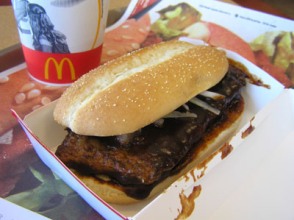 These two items seem as far removed as the people who eat the sandwich and those who actually use a yoga mat, but they share something in common that is wildly alarming and worth having a look.
These two items seem as far removed as the people who eat the sandwich and those who actually use a yoga mat, but they share something in common that is wildly alarming and worth having a look.
Azodicarbonamide, ammonium sulfate and polysorbate 80 are just three of the 70 ingredients that make up the famed McDonald’s BBQ McRib pork sandwich. Even though these nasty ingredients are in small enough quantities that may not otherwise be harmful to your health, it is worth noting how and where else these chemicals are being used just to put it into perspective.
The biggest one that will get some of you squirming in your seat is azodicarbonamide, a flour-bleaching agent found in the McRib bun. This chemical, in addition to giving your BBQ bun that fresh, white appearance, is also used to manufacture shoes, foam plastics, materials such as gym flooring and believe it or not, yoga mats.
From McRib’s introduction in 1982, the sandwich has disappeared and reappeared, therefore giving it a unique following some might refer to as cult-like. With its own Facebook page and Twitter account, the McRib has made headlines, tweets and posts that it is resurfacing yet again, but for a limited time only. McRib Locator websites can direct you to the legendary sandwich. Eat one if you don’t mind something that also contains the very stuff that will keep you from slipping on your own perspiration in a hot yoga class while trying to sweat out the 980 mg of sodium it contains. But then again, if you are doing yoga you are probably not going to be receiving McRib tweets any time soon.
I did a little bit more research and found 414 common food items that also contain azodicarbonamide. This is good information to know even if you don’t eat at McDonald’s (or do yoga). Aside from some of the other fast food chain buns and breads, additional foods labeled as “all natural” whole wheat breads, muffins, croutons and bagels also have this nasty chemical in their ingredients list.
Azodicarbonamide is banned as a food additive in Europe and Australia because of its possible contribution to respiratory problems such as asthma.
via: healthland.time.com
Also Read:
The Real Origins of the McRib Sandwich
8 Chemical Food Additives You Should Avoid
FDA Doesn’t Know if Chemical Found in Foods are Dangerous
